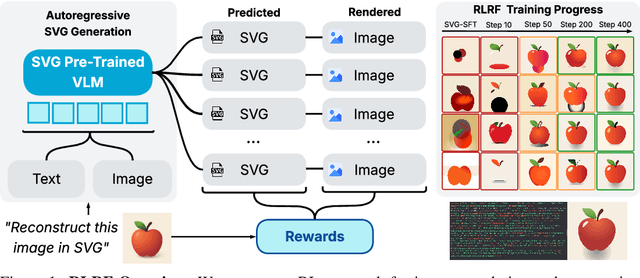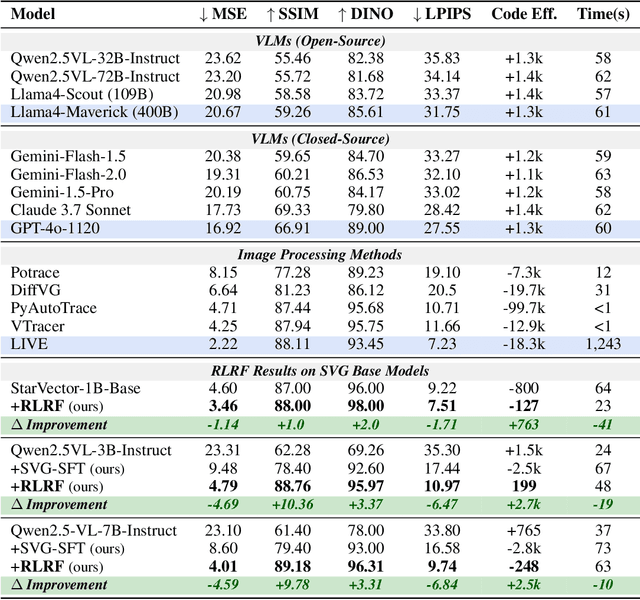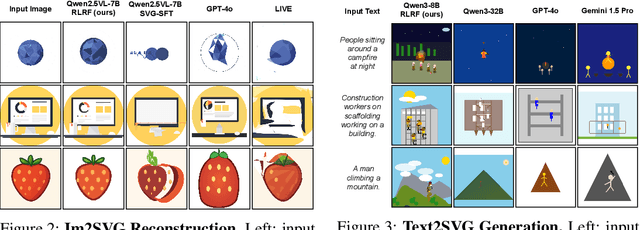Marco Pedersoli
ETS
High-Rate Mixout: Revisiting Mixout for Robust Domain Generalization
Oct 08, 2025Abstract:Ensembling fine-tuned models initialized from powerful pre-trained weights is a common strategy to improve robustness under distribution shifts, but it comes with substantial computational costs due to the need to train and store multiple models. Dropout offers a lightweight alternative by simulating ensembles through random neuron deactivation; however, when applied to pre-trained models, it tends to over-regularize and disrupt critical representations necessary for generalization. In this work, we investigate Mixout, a stochastic regularization technique that provides an alternative to Dropout for domain generalization. Rather than deactivating neurons, Mixout mitigates overfitting by probabilistically swapping a subset of fine-tuned weights with their pre-trained counterparts during training, thereby maintaining a balance between adaptation and retention of prior knowledge. Our study reveals that achieving strong performance with Mixout on domain generalization benchmarks requires a notably high masking probability of 0.9 for ViTs and 0.8 for ResNets. While this may seem like a simple adjustment, it yields two key advantages for domain generalization: (1) higher masking rates more strongly penalize deviations from the pre-trained parameters, promoting better generalization to unseen domains; and (2) high-rate masking substantially reduces computational overhead, cutting gradient computation by up to 45% and gradient memory usage by up to 90%. Experiments across five domain generalization benchmarks, PACS, VLCS, OfficeHome, TerraIncognita, and DomainNet, using ResNet and ViT architectures, show that our approach, High-rate Mixout, achieves out-of-domain accuracy comparable to ensemble-based methods while significantly reducing training costs.
Revisiting Mixout: An Overlooked Path to Robust Finetuning
Oct 08, 2025Abstract:Finetuning vision foundation models often improves in-domain accuracy but comes at the cost of robustness under distribution shift. We revisit Mixout, a stochastic regularizer that intermittently replaces finetuned weights with their pretrained reference, through the lens of a single-run, weight-sharing implicit ensemble. This perspective reveals three key levers that govern robustness: the \emph{masking anchor}, \emph{resampling frequency}, and \emph{mask sparsity}. Guided by this analysis, we introduce GMixout, which (i) replaces the fixed anchor with an exponential moving-average snapshot that adapts during training, and (ii) regulates masking period via an explicit resampling-frequency hyperparameter. Our sparse-kernel implementation updates only a small fraction of parameters with no inference-time overhead, enabling training on consumer-grade GPUs. Experiments on benchmarks covering covariate shift, corruption, and class imbalance, ImageNet / ImageNet-LT, DomainNet, iWildCam, and CIFAR100-C, GMixout consistently improves in-domain accuracy beyond zero-shot performance while surpassing both Model Soups and strong parameter-efficient finetuning baselines under distribution shift.
VLOD-TTA: Test-Time Adaptation of Vision-Language Object Detectors
Oct 01, 2025Abstract:Vision-language object detectors (VLODs) such as YOLO-World and Grounding DINO achieve impressive zero-shot recognition by aligning region proposals with text representations. However, their performance often degrades under domain shift. We introduce VLOD-TTA, a test-time adaptation (TTA) framework for VLODs that leverages dense proposal overlap and image-conditioned prompt scores. First, an IoU-weighted entropy objective is proposed that concentrates adaptation on spatially coherent proposal clusters and reduces confirmation bias from isolated boxes. Second, image-conditioned prompt selection is introduced, which ranks prompts by image-level compatibility and fuses the most informative prompts with the detector logits. Our benchmarking across diverse distribution shifts -- including stylized domains, driving scenes, low-light conditions, and common corruptions -- shows the effectiveness of our method on two state-of-the-art VLODs, YOLO-World and Grounding DINO, with consistent improvements over the zero-shot and TTA baselines. Code : https://github.com/imatif17/VLOD-TTA
MuSACo: Multimodal Subject-Specific Selection and Adaptation for Expression Recognition with Co-Training
Aug 17, 2025Abstract:Personalized expression recognition (ER) involves adapting a machine learning model to subject-specific data for improved recognition of expressions with considerable interpersonal variability. Subject-specific ER can benefit significantly from multi-source domain adaptation (MSDA) methods, where each domain corresponds to a specific subject, to improve model accuracy and robustness. Despite promising results, state-of-the-art MSDA approaches often overlook multimodal information or blend sources into a single domain, limiting subject diversity and failing to explicitly capture unique subject-specific characteristics. To address these limitations, we introduce MuSACo, a multi-modal subject-specific selection and adaptation method for ER based on co-training. It leverages complementary information across multiple modalities and multiple source domains for subject-specific adaptation. This makes MuSACo particularly relevant for affective computing applications in digital health, such as patient-specific assessment for stress or pain, where subject-level nuances are crucial. MuSACo selects source subjects relevant to the target and generates pseudo-labels using the dominant modality for class-aware learning, in conjunction with a class-agnostic loss to learn from less confident target samples. Finally, source features from each modality are aligned, while only confident target features are combined. Our experimental results on challenging multimodal ER datasets: BioVid and StressID, show that MuSACo can outperform UDA (blending) and state-of-the-art MSDA methods.
Low-Rank Expert Merging for Multi-Source Domain Adaptation in Person Re-Identification
Aug 09, 2025Abstract:Adapting person re-identification (reID) models to new target environments remains a challenging problem that is typically addressed using unsupervised domain adaptation (UDA) methods. Recent works show that when labeled data originates from several distinct sources (e.g., datasets and cameras), considering each source separately and applying multi-source domain adaptation (MSDA) typically yields higher accuracy and robustness compared to blending the sources and performing conventional UDA. However, state-of-the-art MSDA methods learn domain-specific backbone models or require access to source domain data during adaptation, resulting in significant growth in training parameters and computational cost. In this paper, a Source-free Adaptive Gated Experts (SAGE-reID) method is introduced for person reID. Our SAGE-reID is a cost-effective, source-free MSDA method that first trains individual source-specific low-rank adapters (LoRA) through source-free UDA. Next, a lightweight gating network is introduced and trained to dynamically assign optimal merging weights for fusion of LoRA experts, enabling effective cross-domain knowledge transfer. While the number of backbone parameters remains constant across source domains, LoRA experts scale linearly but remain negligible in size (<= 2% of the backbone), reducing both the memory consumption and risk of overfitting. Extensive experiments conducted on three challenging benchmarks: Market-1501, DukeMTMC-reID, and MSMT17 indicate that SAGE-reID outperforms state-of-the-art methods while being computationally efficient.
Rendering-Aware Reinforcement Learning for Vector Graphics Generation
May 27, 2025



Abstract:Scalable Vector Graphics (SVG) offer a powerful format for representing visual designs as interpretable code. Recent advances in vision-language models (VLMs) have enabled high-quality SVG generation by framing the problem as a code generation task and leveraging large-scale pretraining. VLMs are particularly suitable for this task as they capture both global semantics and fine-grained visual patterns, while transferring knowledge across vision, natural language, and code domains. However, existing VLM approaches often struggle to produce faithful and efficient SVGs because they never observe the rendered images during training. Although differentiable rendering for autoregressive SVG code generation remains unavailable, rendered outputs can still be compared to original inputs, enabling evaluative feedback suitable for reinforcement learning (RL). We introduce RLRF(Reinforcement Learning from Rendering Feedback), an RL method that enhances SVG generation in autoregressive VLMs by leveraging feedback from rendered SVG outputs. Given an input image, the model generates SVG roll-outs that are rendered and compared to the original image to compute a reward. This visual fidelity feedback guides the model toward producing more accurate, efficient, and semantically coherent SVGs. RLRF significantly outperforms supervised fine-tuning, addressing common failure modes and enabling precise, high-quality SVG generation with strong structural understanding and generalization.
BAH Dataset for Ambivalence/Hesitancy Recognition in Videos for Behavioural Change
May 25, 2025



Abstract:Recognizing complex emotions linked to ambivalence and hesitancy (A/H) can play a critical role in the personalization and effectiveness of digital behaviour change interventions. These subtle and conflicting emotions are manifested by a discord between multiple modalities, such as facial and vocal expressions, and body language. Although experts can be trained to identify A/H, integrating them into digital interventions is costly and less effective. Automatic learning systems provide a cost-effective alternative that can adapt to individual users, and operate seamlessly within real-time, and resource-limited environments. However, there are currently no datasets available for the design of ML models to recognize A/H. This paper introduces a first Behavioural Ambivalence/Hesitancy (BAH) dataset collected for subject-based multimodal recognition of A/H in videos. It contains videos from 224 participants captured across 9 provinces in Canada, with different age, and ethnicity. Through our web platform, we recruited participants to answer 7 questions, some of which were designed to elicit A/H while recording themselves via webcam with microphone. BAH amounts to 1,118 videos for a total duration of 8.26 hours with 1.5 hours of A/H. Our behavioural team annotated timestamp segments to indicate where A/H occurs, and provide frame- and video-level annotations with the A/H cues. Video transcripts and their timestamps are also included, along with cropped and aligned faces in each frame, and a variety of participants meta-data. We include results baselines for BAH at frame- and video-level recognition in multi-modal setups, in addition to zero-shot prediction, and for personalization using unsupervised domain adaptation. The limited performance of baseline models highlights the challenges of recognizing A/H in real-world videos. The data, code, and pretrained weights are available.
Distilling semantically aware orders for autoregressive image generation
Apr 23, 2025Abstract:Autoregressive patch-based image generation has recently shown competitive results in terms of image quality and scalability. It can also be easily integrated and scaled within Vision-Language models. Nevertheless, autoregressive models require a defined order for patch generation. While a natural order based on the dictation of the words makes sense for text generation, there is no inherent generation order that exists for image generation. Traditionally, a raster-scan order (from top-left to bottom-right) guides autoregressive image generation models. In this paper, we argue that this order is suboptimal, as it fails to respect the causality of the image content: for instance, when conditioned on a visual description of a sunset, an autoregressive model may generate clouds before the sun, even though the color of clouds should depend on the color of the sun and not the inverse. In this work, we show that first by training a model to generate patches in any-given-order, we can infer both the content and the location (order) of each patch during generation. Secondly, we use these extracted orders to finetune the any-given-order model to produce better-quality images. Through our experiments, we show on two datasets that this new generation method produces better images than the traditional raster-scan approach, with similar training costs and no extra annotations.
Learning from Stochastic Teacher Representations Using Student-Guided Knowledge Distillation
Apr 19, 2025Abstract:Advances in self-distillation have shown that when knowledge is distilled from a teacher to a student using the same deep learning (DL) architecture, the student performance can surpass the teacher particularly when the network is overparameterized and the teacher is trained with early stopping. Alternatively, ensemble learning also improves performance, although training, storing, and deploying multiple models becomes impractical as the number of models grows. Even distilling an ensemble to a single student model or weight averaging methods first requires training of multiple teacher models and does not fully leverage the inherent stochasticity for generating and distilling diversity in DL models. These constraints are particularly prohibitive in resource-constrained or latency-sensitive applications such as wearable devices. This paper proposes to train only one model and generate multiple diverse teacher representations using distillation-time dropout. However, generating these representations stochastically leads to noisy representations that are misaligned with the learned task. To overcome this problem, a novel stochastic self-distillation (SSD) training strategy is introduced for filtering and weighting teacher representation to distill from task-relevant representations only, using student-guided knowledge distillation (SGKD). The student representation at each distillation step is used as authority to guide the distillation process. Experimental results on real-world affective computing, wearable/biosignal datasets from the UCR Archive, the HAR dataset, and image classification datasets show that the proposed SSD method can outperform state-of-the-art methods without increasing the model size at both training and testing time, and incurs negligible computational complexity compared to state-of-the-art ensemble learning and weight averaging methods.
Progressive Multi-Source Domain Adaptation for Personalized Facial Expression Recognition
Apr 05, 2025Abstract:Personalized facial expression recognition (FER) involves adapting a machine learning model using samples from labeled sources and unlabeled target domains. Given the challenges of recognizing subtle expressions with considerable interpersonal variability, state-of-the-art unsupervised domain adaptation (UDA) methods focus on the multi-source UDA (MSDA) setting, where each domain corresponds to a specific subject, and improve model accuracy and robustness. However, when adapting to a specific target, the diverse nature of multiple source domains translates to a large shift between source and target data. State-of-the-art MSDA methods for FER address this domain shift by considering all the sources to adapt to the target representations. Nevertheless, adapting to a target subject presents significant challenges due to large distributional differences between source and target domains, often resulting in negative transfer. In addition, integrating all sources simultaneously increases computational costs and causes misalignment with the target. To address these issues, we propose a progressive MSDA approach that gradually introduces information from subjects based on their similarity to the target subject. This will ensure that only the most relevant sources from the target are selected, which helps avoid the negative transfer caused by dissimilar sources. We first exploit the closest sources to reduce the distribution shift with the target and then move towards the furthest while only considering the most relevant sources based on the predetermined threshold. Furthermore, to mitigate catastrophic forgetting caused by the incremental introduction of source subjects, we implemented a density-based memory mechanism that preserves the most relevant historical source samples for adaptation. Our experiments show the effectiveness of our proposed method on pain datasets: Biovid and UNBC-McMaster.
 Add to Chrome
Add to Chrome Add to Firefox
Add to Firefox Add to Edge
Add to Edge